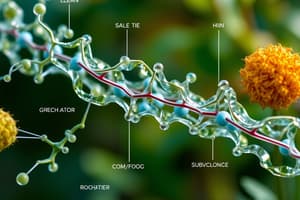Podcast
Questions and Answers
What is an autotroph?
What is an autotroph?
- An organism that produces food from inorganic compounds
- An organism that captures energy from sunlight
- An organism that consumes food for energy
- Both A and C (correct)
What is a heterotroph?
What is a heterotroph?
An organism that obtains energy from the food it consumes.
What does ATP stand for?
What does ATP stand for?
Adenosine Triphosphate
What is photosynthesis?
What is photosynthesis?
What is a pigment?
What is a pigment?
What is chlorophyll?
What is chlorophyll?
What is a thylakoid?
What is a thylakoid?
What is a photosystem?
What is a photosystem?
What is stroma?
What is stroma?
What is NADP+?
What is NADP+?
What is ATP synthase?
What is ATP synthase?
What is the Calvin cycle?
What is the Calvin cycle?
Flashcards are hidden until you start studying
Study Notes
Vocabulary Words Related to Photosynthesis
- Autotroph: Organisms that produce their own food by capturing energy from sunlight or chemicals using inorganic compounds; referred to as producers.
- Heterotroph: Organisms that derive energy by consuming food; known as consumers.
- Adenosine Triphosphate (ATP): Primary chemical used by living organisms to store and release energy, essential for cellular functions.
Processes and Structures in Photosynthesis
- Photosynthesis: A crucial biological process where plants and some organisms convert water and carbon dioxide into oxygen and carbohydrates (like sugars and starches) using light energy.
- Pigment: Molecules that absorb light, playing a significant role in photosynthesis.
- Chlorophyll: The main pigment in plants and photosynthetic organisms, vital for capturing light energy.
Components of Chloroplasts
- Thylakoid: Membrane structures within chloroplasts that contain chlorophyll and are integral to the light-dependent reactions of photosynthesis.
- Photosystem: Functional units in chloroplasts that collect light energy for photosynthesis.
- Stroma: The fluid-filled space surrounding thylakoids in chloroplasts, where the Calvin Cycle occurs.
Energy Carriers and Enzymatic Functions
- NADP+: A carrier molecule that transfers high-energy electrons from chlorophyll to other molecules, playing a key role in the electron transport chain.
- ATP Synthase: A large protein that synthesizes ATP by using energy from H+ ions, illustrating the connection between ionic movement and energy production.
The Calvin Cycle
- Calvin Cycle: A series of biochemical reactions in photosynthesis that utilize ATP and NADPH to synthesize high-energy compounds like sugars, showcasing the transformation of solar energy into chemical energy.
Studying That Suits You
Use AI to generate personalized quizzes and flashcards to suit your learning preferences.




